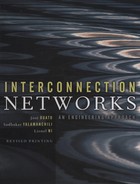Book Description
The performance of most digital systems today is limited by their communication or interconnection, not by their logic or memory. As designers strive to make more efficient use of scarce interconnection bandwidth, interconnection networks are emerging as a nearly universal solution to the system-level communication problems for modern digital systems.
Interconnection networks have become pervasive in their traditional application as processor-memory and processor-processor interconnect. Point-to-point interconnection networks have replaced buses in an ever widening range of applications that include on-chip interconnect, switches and routers, and I/O systems.
In this book, the authors present in a structured way the basic underlying concepts of most interconnection networks and provide representative solutions that have been implemented in the industry or proposed in the research literature.
* Gives a coherent, comprehensive treatment of the entire field
* Presents a formal statement of the basic concepts, alternative design choices, and design trade-offs
* Provides thorough classifications, clear descriptions, accurate definitions, and unified views to structure the knowledge on interconnection networks
* Focuses on issues critical to designers
Table of Contents
- Cover image
- Title page
- Table of Contents
- About the Authors
- Copyright
- Dedication
- Foreword
- Foreword to the First Printing
- Preface
- Chapter 1: Introduction
- Chapter 2: Message Switching Layer
- Chapter 3: Deadlock, Livelock, and Starvation
- Chapter 4: Routing Algorithms
- 4.1 Taxonomy of Routing Algorithms
- 4.2 Deterministic Routing Algorithms
- 4.3 Partially Adaptive Algorithms
- 4.4 Fully Adaptive Algorithms
- 4.5 Maximally Adaptive Routing Algorithms
- 4.6 Nonminimal Routing Algorithms
- 4.7 Backtracking Protocols
- 4.8 Routing in MINs
- 4.9 Routing in Switch-Based Networks with Irregular Topologies
- 4.10 Resource Allocation Policies
- 4.11 Engineering Issues
- 4.12 Commented References
- Chapter 5: Collective Communication Support
- 5.1 Collective Communication Services
- 5.2 System Support for Collective Communication
- 5.3 Preliminary Considerations
- 5.4 Models for Multicast Communication
- 5.5 Hardware Implementations of Multicast
- 5.6 Hardware Support for Barrier Synchronization and Reduction
- 5.7 Software Implementations of Multicast
- 5.8 Engineering Issues
- 5.9 Commented References
- Chapter 6: Fault-Tolerant Routing
- 6.1 Fault-Induced Deadlock and Livelock
- 6.2 Channel and Network Redundancy
- 6.3 Fault Models
- 6.4 Fault-Tolerant Routing in SAF and VCT Networks
- 6.5 Fault-Tolerant Routing in Wormhole-Switched Networks
- 6.6 Fault-Tolerant Routing in PCS and Scouting Networks
- 6.7 Dynamic Fault Recovery
- 6.8 Engineering Issues
- 6.9 Commented References
- Chapter 7: Network Architectures
- Chapter 8: Messaging Layer Software
- Chapter 9: Performance Evaluation
- 9.1 Performance Metrics and Normalized Results
- 9.2 Workload Models
- 9.3 Comparison of Switching Techniques
- 9.4 Comparison of Routing Algorithms
- 9.5 Effect of Message Length
- 9.6 Effect of Network Size
- 9.7 Impact of Design Parameters
- 9.8 Comparison of Routing Algorithms for Irregular Topologies
- 9.9 Injection Limitation
- 9.10 Impact of Router Delays on Performance
- 9.11 Performance of Collective Communication
- 9.12 Software Messaging Layer
- 9.13 Performance of Fault-Tolerant Algorithms
- 9.14 Conclusions
- 9.15 Commented References
- Appendix A: Formal Definitions for Deadlock Avoidance
- Appendix B: Acronyms
- References
- Index
